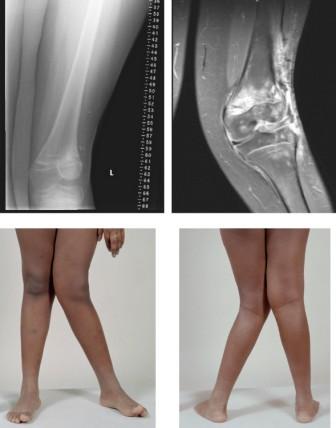Genu valgum
| Genu valgum | |
 |
|---|
|
WikiDoc Resources for Genu valgum |
|
Articles |
|---|
|
Most recent articles on Genu valgum Most cited articles on Genu valgum |
|
Media |
|
Powerpoint slides on Genu valgum |
|
Evidence Based Medicine |
|
Clinical Trials |
|
Ongoing Trials on Genu valgum at Clinical Trials.gov Clinical Trials on Genu valgum at Google
|
|
Guidelines / Policies / Govt |
|
US National Guidelines Clearinghouse on Genu valgum
|
|
Books |
|
News |
|
Commentary |
|
Definitions |
|
Patient Resources / Community |
|
Patient resources on Genu valgum Discussion groups on Genu valgum Patient Handouts on Genu valgum Directions to Hospitals Treating Genu valgum Risk calculators and risk factors for Genu valgum
|
|
Healthcare Provider Resources |
|
Causes & Risk Factors for Genu valgum |
|
Continuing Medical Education (CME) |
|
International |
|
|
|
Business |
|
Experimental / Informatics |
Editor-In-Chief: C. Michael Gibson, M.S., M.D. [1] Associate Editor(s)-in-Chief: Cafer Zorkun, M.D., Ph.D. [2] Luke Rusowicz-Orazem, B.S.
Overview
Genu valgum, commonly called "knock-knees", is a condition where the knees angle in and touch one another when the legs are straightened. Individuals with severe valgus deformities are typically unable to touch their feet together while simultaneously straightening the legs. The term originates from the Latin genu, "knee", and valgum, "bowlegged".[1]
Mild genu valgum is relatively common in children up to two years of age, and is often corrected naturally as children grow and develop. However, the condition may continue or worsen with age, particularly when it is the result of a disease, such as rickets or obesity. Idiopathic is the term used to describe genu valgum that is congenital or has no known cause.
Other systemic conditions may be associated, such as Schnyder Central Corneal Dystrophy, an autosomal dominant condition frequently reported with hyperlipidemia.
Causes
Life Threatening Causes
Common Causes
- Acrocephalopolysyndactyly type 2
- Alves castelo dos santos syndrome
- Ampola syndrome
- Aromatase deficiency
- Chondroectodermal dysplasia
- Chromosome 7
- Chromosome 7p duplication syndrome
- Cohen syndrome
- Down syndrome
- Duplication 7p
- Ellis-van creveld syndrome
- Epiphyseal dysplasia
- Fibular hemimelia
- Focal fibrocartilaginous dysplasia
- Galactosamine-6-sulfatase deficiency
- Hereditary multiple exostoses
- Metaphyseal chondrodysplasia
- Mucopolysaccharidosis type iv
- Multiple epiphyseal dysplasia syndrome
- Multiple hereditary exostoses
- Osteogenesis imperfecta
- Oto-facio-osseous-gonadal syndrome
- Parastremmatic dwarfism
- Pseudoachondroplasia
- Wagner syndrome
Causes by Organ System
Causes in Alphabetical Order
- Acrocephalopolysyndactyly type 2
- Alves castelo dos santos syndrome
- Ampola syndrome
- Aromatase deficiency
- Blounts disease
- Chondroectodermal dysplasia
- Chromosome 7, trisomy 7q
- Chromosome 7q duplication syndrome
- Cohen syndrome
- Cozen fracture
- Distal femoral physeal fracture
- Down syndrome
- Ellis-van creveld syndrome
- Epiphyseal dysplasia
- Fibular hemimelia
- Focal fibrocartilaginous dysplasia
- Galactosamine-6-sulfatase deficiency
- Hemophilic arthritis
- Hereditary multiple exostoses
- Homocystinuria
- Hypophosphatemic rickets
- Iliotibial band tightness
- Injury to growth plates
- Limb deficiencies
- Mental retardation
- Metaphyseal chondrodysplasia
- Morquio's disease
- Mucopolysaccharidosis type iv
- Multiple epiphyseal dysplasia syndrome
- Multiple hereditary exostoses
- Neurofibromatosis
- Obesity
- Ollier's disease
- Osteoarthritis
- Osteochondroma
- Osteogenesis imperfecta
- Osteomalacia
- Osteomyelitis
- Osteopetrosis
- Oto-facio-osseous-gonadal syndrome
- Parastremmatic dwarfism
- Physiologic valgus
- Proximal tibial physeal fracture
- Pseudoachondroplasia
- Renal osteodystrophy
- Rhematoid arthritis
- Rheumatoid disease
- Rickets
- Sclerosteosis
- Spondyloepiphyseal dysplasia tarda
- Vitamin c deficiency
- Wagner syndrome
Treatment
Generally, there is no known cure for knock knees post-childhood. Contrary to common belief, no amount of orthotic treatment or bodybuilding exercise will straighten knock knees for adults. If the condition persists or worsens into late childhood and adulthood, a corrective osteotomy may be recommended to straighten the legs. This however is more of a cosmetic remedy, and may hamper athletic performance in the future.
Adults with uncorrected genu valgum are typically prone to injury and chronic knee problems such as chondromalacia and osteoarthritis. In some cases, total knee replacement (TKR) surgery may be required later in life to relieve pain and complications resulting from severe genu valgum.
Diagnostic test
The Q angle which is formed by a line drawn from the anterosuperior iliac spine through the center of the patella and a line drawn from the center of the patella to the center of the tibial tubercle, should be measured next. In women, the Q angle should be less than 22 degrees with the knee in extension and less than 9 degrees with the knee in 90 degrees of flexion. In men, the Q angle should be less than 18 degrees with the knee in extension and less than 8 degrees with the knee in 90 degrees of flexion.
References
- ↑ "valgus. The American Heritage Dictionary of the English Language: Fourth Edition. 2000". Retrieved 2007-08-29.
See also
External links
- orthoped/495 at eMedicine
- Template:GPNotebook
- Genu valgum, from Duke University's Wheeless' Textbook of Orthopaedics
Template:Diseases of the musculoskeletal system and connective tissue